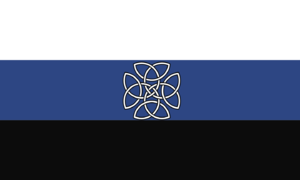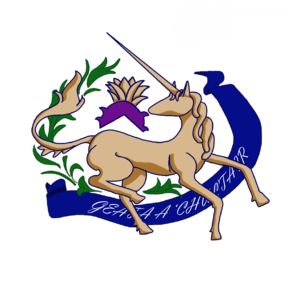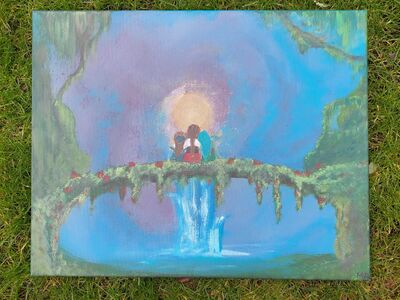Difference between revisions of "The United Provinces of Dùnrath"
MNT Plovdiv (talk | contribs) (→Administrative Division) |
MNT Plovdiv (talk | contribs) m (→Government and Political System) |
||
| Line 126: | Line 126: | ||
==Government and Political System== | ==Government and Political System== | ||
| − | Dùnrath is a semi-constitutional monarchy, with the [[Clan Sutherland| The United Clans of Barr and Suther]] as the sole legitimate | + | Dùnrath is a semi-constitutional monarchy, with the [[Clan Sutherland| The United Clans of Barr and Suther]] as the sole legitimate ruling clans. The Clan Chief of the United Clans will automatically be the Grand Governor of the United Provinces. The Grand Governor has a high degree Administrative and Diplomatic rights, however they do not have absolutely power on Dùnrath's Judicial and Legislative matters. The Rathonian Ashguards are responsible for Dùnrath's Justice under the Rathonian Laws, which includes the Rathonian Basic Law and Rathonian Civil Law. The political organisation of the Rathonian People's Council decides on Dùnrath's law. The Rathonian People's Council consist of Local Governors and the Grand Governor's Cabinet. <br> |
The Local Governors are governors that are appointed by the Grand Governor, they have administrative power in their assigned provinces that can only vetoed by the Grand Governor, but in actual practice, the Grand Governor seldom interfere with provincial administrative matters unless it goes out of control and residents of that particular province objects about it. <br> | The Local Governors are governors that are appointed by the Grand Governor, they have administrative power in their assigned provinces that can only vetoed by the Grand Governor, but in actual practice, the Grand Governor seldom interfere with provincial administrative matters unless it goes out of control and residents of that particular province objects about it. <br> | ||
| − | The Grand | + | The Grand Governor's Cabinet are members that assists the Grand Governor in a broader scale, instead of focusing on individual provinces, they focus on the entirety of Dùnrath. The leader of the Grand Governor's Cabinet is the First Minister, which starting from year 82 of the Second Age will be elected by the general public and elections will be held once every 12 years. Under the First Minister, there are Cabinet Secretaries in charge of different aspects of Dùnrath's day to day operation. The Cabinet Secretaries can be appointed by the First Minister or the Grand Governor and they appoint people onto the position by their specialities. <br> |
| − | As of Year | + | As of Year 74 of the Second Age, Cabinet Secretaries are as the following: <br> |
*Cabinet Secretary for Law | *Cabinet Secretary for Law | ||
*Cabinet Secretary for Health | *Cabinet Secretary for Health | ||
| Line 136: | Line 136: | ||
*Cabinet Secretary for Architecture | *Cabinet Secretary for Architecture | ||
*Cabinet Secretary for Agriculture and Communications | *Cabinet Secretary for Agriculture and Communications | ||
| + | *Cabinet Secretary for Internal Affairs | ||
<br> | <br> | ||
| + | |||
==Georgraphy== | ==Georgraphy== | ||
===Physical Georgraphy=== | ===Physical Georgraphy=== | ||
Revision as of 01:03, 7 May 2022
| ||||||||||||||||||||||||||||||||||||||||||||||||||||||||||||||||
The United Provinces of Dùnrath, of which also known in full commons as The United Provinces of Dunrae, Vestlandet and the Borders, or known simply as Dùnrath or The United Provinces (Common: Dunrae (/dʌn.ˈre/),Sveasspråk: Ratteborg) is a monarchical political entity made up of individuals of different races. It was established after the Proclamation of the United Provinces in year 70 of the second age by the last Jarl of Dùnrath, Dùghlas Sutharlainn, of which he decided to divide up his power to other governmental departments.
History
Pre-War of Wigs Era (42 – 60 S.A.)
Before year 42 of the Second Age, even though the sovereignty was secured by the Norlandic Government from the Raenrland Decree on year 20 of the second age, its population is highly concentrated to the western part of the region, closer to the Norland Proper. On the other hand, the South-eastern part of Raenrland was sparsely inhabited by nomads and tribal people of the region, of which will be called the “Aboriginals” in the future by the Rathonian Authorities. On year 42 of the Second Age, the Sutherland Corporation, at the time a multinational business venture, and the Clan Chief of the United Clans of Barr and Suther, Daibhidh MacFhilib Sutharlainn stroked a deal with the Norland King at the time, Vane Freysson Ruric, to set up a merchant political entity in the South-eastern part of Raenrland, and they both signed the Helmsdale Agreement to warrant the creation of a new political entity, of which Norland sold the lands of Rath and Vestlandet to the United Clans. Soon, the news of the new established merchant colony spread across the continent and attracted a substantial amount of Sutican and Urguani people to move into the colony and cultivate the virgin land. On year 45, Daibhidh Sutharlainn decided to enact Article 6 of the Helmsdale Agreement of which he is reorganising the merchant colony to a Barony of the Kingdom of Norland, named the Barony of Dùnrath. The barony was given a substantial amount of autonomy under the Kingdom of Norland by the Helmsdale Agreement and the Rathonian Diplomatic Agreement, of which ensured the absolute independent in all Legislative, Administrative and Judicial matters, and partial-independent in Diplomatic matter. The Barony then exist under the Kingdom of Norland as, “A Political Entity of the Kingdom of Norland with a high degree of autonomy”. On year 53 of the Second Age, the Baron of Dùnrath at the time, once again stroked another deal with the King of Norland to expand its borders to tackle the over-population issue in the city of Dùnrath. Hence the South Dunbar Agreement was officially signed, which Norland sold the lands of Osmode, Östlandet, South Dunbar and Gräns-Kristianstad to the United Clans. Moreover, the United Clans of Barr and Suther was also given a Jaric title by the Norlandic Government. This marked the border and the political position of the Pre-United Province of Dùnrath. On year 56 of the Second Age, the Jarl of Dùnrath at the time agreed to sell land to the clan leader of the Anarórë Clan, Boots Anarórë and set up a fortified villiage by the Gräns-Kristianstad neighbourhood, and the villiage was subsequently named in Waldenian as Grenzstadt (Agnesa:Baile nan Crìochan, Sveasspråk: Gränsstad), not long after that, the Norlandic Crown gave the title of Laird of Grenzstadt to the Anarórë Clan. The Lairdship takes up around 40% of land of the current day Province of Gräns- Bromölla.
War of Wigs Era (60 – 70 S.A.)
The Kingdom of Norland joined the War of Wigs from year 54. However, it is not until year 60 that the Rathonian Government start preparing for possible military engagement with the Holy Orenian Empire at the time. On year 61, the Orenian Army, known as the Imperial State Army (ISA) started large scale of assaults throughout the Southern Borders and threatened the safety of rural areas of the Jarldom. On year 63, the ISA launched a full-scale raid throughout the lands of Norland, from Krew, Varhelm, and Dùnrath. Hence a skirmish happened between the ISA and the Rathonian Citizens, since at the time there were no Ashguard Garrisons in the region. The Rathonian Citizen Units, being way more underprepared and inexperienced in comparison with the ISA lost the battle against them and the ISA subsequently raided the Little Matilda Ranch in Osmonde, this is known in history as the Skirmish of Osmonde-Östlandet. That particular action sparked the Anti-Oren sentiment in Dùnrath and strengthen the determination of winning the war. The Rathonians have participated in several operations and skirmishes including the Sacking of Stone Tower, the Battle of Haverlock Fields, and the Siege of Haverlock. On year 69, which is the year before the Battle of East Fleet, following the statement by the Marshal of Norland at the time, Ragnvald Eiriksson Ruric, the People’s Council of Dùnrath also issued a statement with the heading: “When the Sun Shines Brightly on the Blue Sky.” (Agnesa: Nuair a dheàrrsas a’ ghrian gu soilleir air an speur gorm. Sveasspråk: När solen lyser klart på himmlen blå) which the Rathonian Government condemned the action and warcrimes done by the Orenian Authorities.
United Provinces Era (70 S.A. - Present)
On year 70, two years before the end of the War of Wigs. There was a major earthquake that destroyed all buildings of the western and northern parts of the city of Dùnrath. Dispite there was a mild amount of casualties, the city is mostly destroyed and thus rebuilding was needed. Four days later, the Last Jarl of Dùnrath, Dùghlas Sutharlainn decided to give up part of his administrative power and establish local governors governing their respective regions. Hence the United Provinces of Dùnrath is established, with the last Jarl of Dùnrath as the first Grand Governor of the United Provinces. Two years later, the War of Wigs was ended, and peace was achieved after the war. Subsequently the Rathonian Government started a lot of building projects including the Port of Dun’avi, the Finlaggan Place, and the finalisation of the Östlandet keep. On year 72, the Grand Govenor of Dùnrath and the King of Norland of the time, King Ragnvald Eiriksson Ruric signed the Gräns- Bromölla Agreement, expanding the United Provinces futher and enabled Dùnrath to grow further.
Demographics
The United Provinces have a more diverse demographics in comparison with the entirety of Norland. As it was a settler colony when it was first established, the majority of the citizens currently are not born in Dùnrath. Human takes up roughly half of the population, where elves, especially wood elves takes up 40% of the population, the other 10% consists of Halflings and other races. Dùnrath born Rathonians only takes up 17% of the population, with Norland and Savoy born Rathonians taking up a total of 40% of the population.
Culture
The core cultures of Dùnrath are the Agnethe Culture, which is the predominate culture of the ruling clans, The United Clans of Barr and Suther, and the Svealands Culture, which is the native culture of Southern Raenrland before Dùnrath was established. Other cultures could also be found in the city due to the diversity of origin of the population. Cultures are legally protected by the Rathonian Government when the Language and Culture Act was introduced in year 65 of the Second Age.
Language
The official languages of the United Provinces are Commons, Agnesa and Sveasspråk. The first two were fomalised by the Language and Culture Act (65 S.A.) and Sveasspråk is officialised in a de facto manner due to the Council deciding to respect the local native culture and language. All official documents have to have all three languages as the title and the bureau must create a translation in any of these language by request. The United Provinces also have a list of protected language for languages that are not prominent as an official language, but still have a group of users within the state. Languages such as Ancient Elven and Li-Wen are also used in a daily base in the United Provinces, mainly for Elvenesse-Rathonians and Liren-Rathonians.
Religion
According to the census done by year 71, half of the population are non-religious, and the largest religion in the United Provinces is Agnethe Folk, which accounts to 26% of the population. The second largest religion in the state is the Red Faith, which accounts to 9% of the population. Other minority religions in the region such as Cannonism can also be found in the United Provinces. According to the Basic Law of Dùnrath, all official department has to stay Religiously Neutral, and the Rathonian Government must stay secular. Therefore, religion does not play any major roles in the United Provinces.
Government and Political System
Dùnrath is a semi-constitutional monarchy, with the The United Clans of Barr and Suther as the sole legitimate ruling clans. The Clan Chief of the United Clans will automatically be the Grand Governor of the United Provinces. The Grand Governor has a high degree Administrative and Diplomatic rights, however they do not have absolutely power on Dùnrath's Judicial and Legislative matters. The Rathonian Ashguards are responsible for Dùnrath's Justice under the Rathonian Laws, which includes the Rathonian Basic Law and Rathonian Civil Law. The political organisation of the Rathonian People's Council decides on Dùnrath's law. The Rathonian People's Council consist of Local Governors and the Grand Governor's Cabinet.
The Local Governors are governors that are appointed by the Grand Governor, they have administrative power in their assigned provinces that can only vetoed by the Grand Governor, but in actual practice, the Grand Governor seldom interfere with provincial administrative matters unless it goes out of control and residents of that particular province objects about it.
The Grand Governor's Cabinet are members that assists the Grand Governor in a broader scale, instead of focusing on individual provinces, they focus on the entirety of Dùnrath. The leader of the Grand Governor's Cabinet is the First Minister, which starting from year 82 of the Second Age will be elected by the general public and elections will be held once every 12 years. Under the First Minister, there are Cabinet Secretaries in charge of different aspects of Dùnrath's day to day operation. The Cabinet Secretaries can be appointed by the First Minister or the Grand Governor and they appoint people onto the position by their specialities.
As of Year 74 of the Second Age, Cabinet Secretaries are as the following:
- Cabinet Secretary for Law
- Cabinet Secretary for Health
- Cabinet Secretary for Education and Culture
- Cabinet Secretary for Social Security
- Cabinet Secretary for Architecture
- Cabinet Secretary for Agriculture and Communications
- Cabinet Secretary for Internal Affairs
Georgraphy
Physical Georgraphy
The terrain of Dùnrath is 36% Forest, and only roughly 20% of the current Rathonian land are inhabited. The primarily rugged and mountainous terrain is restricted for habitation. The major habited zones are highly concentrated by the lake side of Loch Fiag, and this is why the Loch has sometimes been called the "Loch of Life" by the Rathonian people. The North and East banks of Loch Fiag are prone to natural disasters such as earthquakes, and the great earthquake happened on Year 69 of the Second Age destroyed the capital city of Dùnrath at the time, causing many to flee to other parts of Dùnrath or Norland.
The main type of tree that can be found in the region is the Grand Dark Oak trees. Other trees such as Birch can be found in the region.
Climate
Dùnrath has a temperate climate that is humid subtropical. Temperatures average around 2 to 6 °C (35 °F - 42 °F)in January and 27 to 30 °C (80 °F - 86 °F) in July. A great majority of the annual rainfall occurs during the summer.
Administrative Division
The United Provinces of Dùnrath consists of 3 provinces, one special capital province, one Autonomous Territory, and one Minor Territory. They are subdivided into 16 communes that serves mainly for geographic purposes. As at Year 75 All Province Governor Positions were abolished by the Reforms of the 32nd Year After Establishment, and
| Colours | Province or others | in Agnesa | in Sveasspråk | Symbol | Communes | Notes |
|---|---|---|---|---|---|---|
| |
Osmonde | Osmonde | Osmonde | ❃ | Little Matilda Oban South Turnip Östlandet Cinged-Östfiag New South Dunbar |
Formally known as Osmonde-Östlandet |
| |
Dun'avi | Dùn Dhaibhidh | Davesborg | ⚘ | Dun'avi | Special Capital Region |
| |
South Dunbar | Dùn Barr a Deas | Söderbarborg | ☘︎ | Fort Catherine South Dunbar Mountains Bromölla (and Östra Kristianstad) |
|
| |
Norraberget | Na Beanntan a Tuath | Norra Berget | ✤ | Bergen North Turnip |
|
| Grenzstadt | Baile nan Crìochan | Gränsstad | ✿ | Grenzstadt Västra Kristianstad |
Autonomous Territory governed by the Laird of Grenzstadt | |
| |
Vestlandet | Fearann an Iar | Västlandet | - | Vestlandet | Uninhabitable, Minor Territory of Dùnrath |
Economy
Whisky is one of Dùnrath's more known goods of economic activity. The ruling clan of Sutherland has been a major producer in whisky for more than 200 years before the establishment of Dùnrath. Since the dawn of Dùnrath, whisky has always been take up a substantial amount of Rathonian Export. For the year ended 72 of the Second Age, Elysium is the largest export destination for Rathonian whiskies, accounting 65% of the sale, followed by Yong Ping with 20% and Norland Proper with 15%.
Agriculture acts as a major player in the Rathonian economy. Agriculture accounted for 30% of total production in the Rathonian Economy in Year 72. Wheat is the principal commodity. Major secondary crops include potatoes and pumpkins, and Carrots mostly grown in the Lairdship of Gränsstad.


